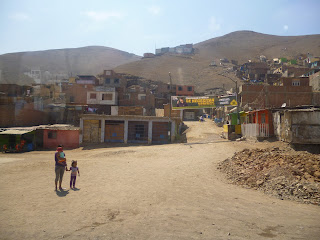| Traffic chaos in central Lima (not my photo) |
There's also the little mototaxis which are faster and cheaper in some areas of the city. Its like a motorbike with seats on the back. Its a bit of a bumpy ride but its exciting too, you see more of the city and they don't go too fast!
There's a bit of a knack to hailing a taxi in Lima. There are hundreds of them to
choose from but not all drivers are trustworthy, many are not registered, to avoid paying taxes, and hardly any of
them are regulated so you're putting your life into the hands of a potential driving maniac when getting into a taxi here.
The other option is the bus. Well, that takes some describing! They are all brightly coloured and have the main stops painted on the sides. Easy no? They are also in various states ranging from brand new with comfy seats, to literally falling apart where you have to avoid falling into the hole in the floor and sit on a wooden bench squashed between ten other people. There are probably thousands of buses in Lima from the little minibus style (called combis), the small buses (micros) and the big bus types (bus). The price you pay depends on where you're going but at its most expensive its only 2 soles (70p) to go from one side of the city to another. Travel is very cheap here but certainly comes with its adventures!
The other option is the bus. Well, that takes some describing! They are all brightly coloured and have the main stops painted on the sides. Easy no? They are also in various states ranging from brand new with comfy seats, to literally falling apart where you have to avoid falling into the hole in the floor and sit on a wooden bench squashed between ten other people. There are probably thousands of buses in Lima from the little minibus style (called combis), the small buses (micros) and the big bus types (bus). The price you pay depends on where you're going but at its most expensive its only 2 soles (70p) to go from one side of the city to another. Travel is very cheap here but certainly comes with its adventures!
Often bus drivers will race
each other at break neck speeds along highways. First to the
corner/bus stop, changing lanes and dodging pedestrians seems to be a
great game for the driver and a real test of his skills at dodging other traffic. Its another story for anyone not used to it. If you're unlucky enough to be standing then its bus surfing
for you as you try to keep your balance and avoid standing on anyone's toes while the bus driver shows off how fast he can drive
and then do an emergency stop.
If you survive this without falling on top of the unfortunate soul standing beside you then you'll probably need to use your gymnastics skills to battle your way off the bus because the conductors (combradores) like to play their own games: how many people can you squeeze into the bus at any one time. Phew, travelling by bus is always an eventful experience and although I was terrified at first, it is growing on me (slowly)!
There's also the little mototaxis which are faster and cheaper in some areas of the city. Its like a motorbike with seats on the back. Its a bit of a bumpy ride but its exciting too, you see more of the city and they don't go too fast!
If you survive this without falling on top of the unfortunate soul standing beside you then you'll probably need to use your gymnastics skills to battle your way off the bus because the conductors (combradores) like to play their own games: how many people can you squeeze into the bus at any one time. Phew, travelling by bus is always an eventful experience and although I was terrified at first, it is growing on me (slowly)!
There's also the little mototaxis which are faster and cheaper in some areas of the city. Its like a motorbike with seats on the back. Its a bit of a bumpy ride but its exciting too, you see more of the city and they don't go too fast!











































